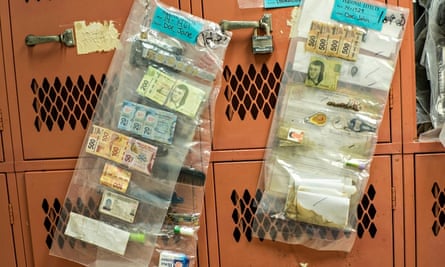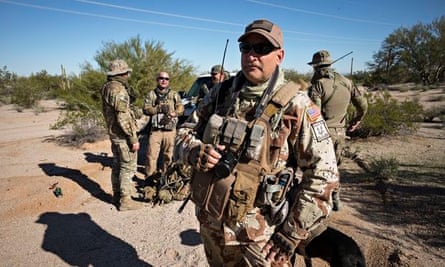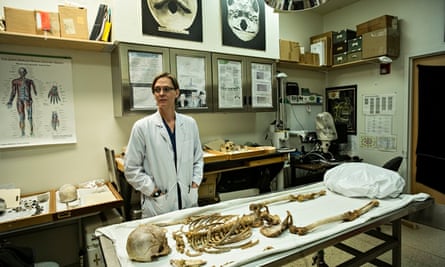At the age of 56 Carmen Martínez knew she could not outrun the border patrol so she glued patches of carpet to her trainers – a low-tech tactic to blur her tracks and gain an edge in the desert contest of cat and mouse.
It didn’t work. A helicopter from US customs and border protection spotted her group as it entered the Arizona desertone recent night, scattering her companions and leaving the Mexican grandmother alone, hiding behind a bush.
It was not much of a contest. Arrayed against her were ground sensors, camera towers, mobile surveillance systems, blimps and drones. A ground patrol swiftly captured her.
Martínez was deported to the Mexican city of Nogales, her hopes of returning to New York, where for 10 years she worked as a restaurant cook, shredded.
“I had to come back to Mexico,” she sobbed, slumped on a Nogales border post bench, tugging at the carpet on her soles. “My dad died and my mum got diabetes. If I didn’t come back I wouldn’t have forgiven myself. Now I’m stuck.”
But at least she is alive. Had Martínez eluded the patrol she would have faced a trek through arid scrub, baking by day, freezing by night, a forbidding desolation even for the young, fit and well-equipped. The corpses of those who succumbed to heat stroke, hypothermia or other perils dot the landscape.

Immigration reform is expected to convulse Washington in 2015, with a Republican-controlled Congress vowing to challenge Barack Obama’s alleged softness on undocumented people and border control.
In fact, in the past six years the number of border agents has doubled to 23,000 and swaths of desert have become militarised. That and a sluggish US economy have curbed the influx.
From a peak in 2000 the number of people trying to illegally cross from Mexico had fallen 80% by 2013. But the number of recorded deaths has remained broadly steady, with an annual average of 394, meaning the proportion of crossers who die has surged. The figure last year was 445.
“Deaths have jumped since traffic was pushed away from the cities and deeper into the desert and treacherous terrain,” said Cameron Jones, a Tucson-based activist with non-profit group No More Deaths.
Arizona’s Tucson sector, which straddles the Sonoran desert, is the deadliest crossing, raising the stakes for the disparate groups that try to help – or repel – the migrants.
On one side are No More Deaths and the Samaritans, which leave water, food, socks and blankets in remote locations.
“If you have the chance to save a life you should take it,” said Patrick Miller-Gamble, 19, a No More Deaths volunteer from Boston, as he bounced in a battered Dodge Ram laden with supplies down Ruby Road, an old mining trail.
A shiny border patrol SUV with agents in camouflage uniform tailed behind for a few miles. After it had gone Miller-Gamble and another volunteer parked the car and hauled backpacks past cacti and mesquite trees to an established dropoff point, only to find the supplies left several weeks earlier untouched. Fewer people were using the trail because of increased enforcement, forcing them to take ever wider loops, said Miller-Gamble’s colleague, who declined to be named. “A checkpoint out here really is a death machine. It’s this thing that you have to get around.”

The pair drove deeper into the desert and scrambled down a ravine to a more remote site about eight miles from the frontier. All the tinned beans and energy bars left previously, plus about eight gallons of water, had gone.
They left fresh supplies and on the water containers wrote messages in Spanish such as “have faith”, “courage” and “good luck”. In response to the provisions left before, migrants had scratched “gracias”.
Supply drops have their own cat-and-mouse component because vandals sabotage them, slashing containers and pouring water on food to spoil it. A secret camera filmed border patrol agents kicking over water containers in this area in 2012. Hunters and rightwing militias are suspected of doing the same.
“When you get close and the beans are rotting the smell hits you,” said Miller-Gamble. “It’s basically giving people a death sentence.”
Activists stage decoy drops to protect the real ones.
Nicole Ballistrea, a spokeswoman for the Tuscon border patrol, said the agency opposed vandalising supplies. It cooperated with Humane Borders, a non-profit organisation, and saved lives by erectingdozens of rescue beacons, she said. “We don’t want to see anyone die.”
No one does, apparently. Not even Harry Hughes, who leads Minutemen and other militia-style patrols with trucks, radios, binoculars and guns, a self-styled desert “taskforce”.
According to Hughes, corrupt US government agencies and banks allied with Marxists have opened the borders to an invasion of drug traffickers and illegal immigrants who steal jobs and leach money from the welfare system. Even so, he said, his patrols sometimes assisted them. “Often we come across people who are dying. We render first aid if necessary, then call border patrol.”
Whatever the individual intentions or actions, US immigration policy remains deadly. Poverty impels people north but the absence of a guest worker programme for agricultural labourers, for instance, sends them on desert treks, a brutal contrast to decades ago when labourers could work for a season and return home, said Edmundo Hidalgo, who heads Chicanos por la Causa, a Phoenix-based non-profit organisation. “For economic reasons many people simply have no option. This flow will never cease.”

Take Martínez: she built a life in New York but had no way to legalise her status. After returning to Mexico for her father’s funeral, her only way back was to pay a smuggler thousands of dollars, clump through harsh terrain in scorching heat, dodging rattlesnakes, thieves and “la migra” – immigration police. And still she went for it.
The border patrol arguably saved her life. But what about the next time she tried? Would they catch her again, would she somehow slip through, as many do, or would she collapse in the sand, gasping, exhausted, abandoned?
Some corpses are discovered and reported within hours, others lie there for years. Once found, they are taken on Interstate 19 to Tucson and an ochre-coloured one-storey building: the Pima county medical examiner’s office. They join other bodies in a large cooler, all in white bags with red tags, stacked six-high on metal traysalmost to the ceiling. The smell is unmistakable.
When the Guardian visited, about 100 of the 150 bodies in the office were border-crossers. The morgue received 130 this year, down from 168 in 2013. In the 1990s before the border crackdown it received an average of 10 “unidentified border crosser” remains a year. “We’re receiving more skeletal remains over time,” said Gregory Hess, the medical examiner.
Many were unidentified, the tags saying John or Jane Doe. Migrants often use fake IDs, so documents found on bodies do not necessarily prove identity. Possessions – cash, nail clippers, soap, lip salve, a Bible, a photo of a solemn small boy in dungarees – are kept in the hope that relatives will claim them, but fear of deportation deters many from contacting authorities, Hess said.
Traci Van Deest, a forensic anthropology postdoctoral fellow, was in another room inspecting the remains of a male, aged 25 to 45, thought to have died between six months and two years ago. “Mostly skeletonised with some mummification tissue,” she said. The hands and feet were missing as were parts of the knees. “Typical of scavenging. Carnivores tend to go for the end of long bones.”
Identified or not, bodies tell a story. Teeth cavities, thin enamel and poorly healed fractures testify to poor nutrition and medical care, said Van Deest. “It indicates a rough start to life.” Ending up here indicates a rough end, too.
She said it was a privilege to chronicle and identify remains. “It’s an honour to be able to provide answers to their families. They deserve to know what happened.”
Comments (…)
Sign in or create your Guardian account to join the discussion